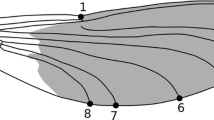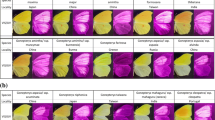Summary
Different species of large tropical butterflies belonging to the genus Morpho vary dramatically in both the amount of blue color on their wings and the associated irridescence (reflectance). This paper discusses how such a morphological properties may be related to both courtship behavior and effective means of reducing predation (especially by birds) in the low density adult populations. Essentially, the hypothesis is advanced that territorial species of Morpho can afford to possess very conspicuous wing coloration that may facilitate courtship interactions, in addition to spacing the territorial male population over the suitable habitat. While territoriality may be favored by natural selection, such behavior can only evolve if the species involved possess effective means of reducing predation, because territoriality in morphos is an extremely predictable form of behavior, toward which predators can easily orient. Two alternate hypotheses are advanced to account for low predation in a territorial morpho, Morpho amathonte, a species in which males are very bright and showy. The first hypothesis, which is more consistent with traditional ideas on the function of bright colors in morpho wings, maintains that predators learn quickly to avoid these butterflies as prey, since they are very difficult to catch. The second hypothesis, suggests that conspicuous territorial male morphos actually employ pursuit-stimuli to invite birds to attack and be subsequently unsuccessful.
Similar content being viewed by others
References
Brower, L. P.: The evolution of sex-linked mimicry in butterflies. Proc. XVI Internat. Congr. Zool. 4, 173–179 (1963).
Coppinger, R. P.: The effect of experience and novelty on avian feeding behavior with reference to the evolution of warning coloration in butterflies. II. Reactions of naive birds to novel insects. Amer. Naturalist 104, 323–335 (1970).
Costa Lima, A. M.: Terceiro catalogo dos insectos que vivem nas plantas do Brasil. Directoria de Estatistica da produccao (Seccao de Publicidade), Rio de Janeiro (1936).
Ehrlich, P. R., Raven, P. H.: Butterflies and plants: a study in coevolution. Evolution 18, 586–608 (1965).
Granit, R.: Receptors and sensory perception. New Haven: Yale University Press 1955.
Margalef, R.: Perspectives in ecological theory. Chicago: Chicago Univ. Press 1968.
Miller, R. S.: Competition and species diversity. In: Diversity and stability in ecological systems. Brookhaven Symposia in Biology, No 22, 63–70 (1969).
Polyak, S.: The vertebrate visual system. Chicago: Chicago Univ. Press 1957.
Slobodkin, L. B., Sanders, H. L. On the contribution of environmental predictability to species diversity. In: Diversity and stability in ecological systems. Brookhaven Symposia in Biology, No 22, 82–95 (1969).
Swihart, S. L.: Neural adaptations in the visual pathway of certain heliconiine butterflies, and related forms, to variations in wing coloration. Zoologica 52, 1–14 (1967).
Whittaker, R. H., Feeny, P. P.: Allelochemics: chemical interactions between species. Science 171, 757–769 (1971).
Wink, W. A., Delevanti, C. H., Jr., Akker, J. A. van den: Instrumentation studies LXXVII. Study on gloss I. A goniophotometric study of high-gloss papers. Tappi (Tech. Assoc. Pulp & Paper Industry) 36, 163–172 (1953)
Young, A. M.: Feeding and flying of Morpho butterflies in a tropical rain forest. Ecology, submitted for publication (1971a).
Young, A. M.: Community ecology of some rain forest butterflies. Amer. Midl. Natur., in press. (1971b).
Young, A. M.: Mating systems and dispersal strategies in sympatric populations of two species of Morpho butterflies in a tropical rain forest. In preparation (1971c).
Young, A. M.: Notes on gregarious roosting in tropical butterflies of the genus Morpho. J. Lepid. Soc., in press (1971d).
Author information
Authors and Affiliations
Rights and permissions
About this article
Cite this article
Young, A.M. Wing coloration and reflectance in Morpho butterflies as related to reproductive behavior and escape from avian predators. Oecologia 7, 209–222 (1971). https://doi.org/10.1007/BF00345212
Received:
Issue Date:
DOI: https://doi.org/10.1007/BF00345212




